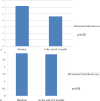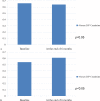The effects of angiotensin-converting enzyme inhibitors on peritoneal protein loss and solute transport in peritoneal dialysis patients
- PMID: 22948453
- PMCID: PMC3416891
- DOI: 10.6061/clinics/2012(08)04
The effects of angiotensin-converting enzyme inhibitors on peritoneal protein loss and solute transport in peritoneal dialysis patients
Abstract
Objective: The objective of this study was to examine the effects of angiotensin-converting enzyme inhibitors on peritoneal membrane transport, peritoneal protein loss, and proteinuria in peritoneal dialysis patients.
Methods: Fifty-four peritoneal dialysis patients were included in the study. The patients were divided into two groups. Group 1 (n = 34) was treated with angiotensin-converting enzyme inhibitors. Group 2 (n = 20) did not receive any antihypertensive drugs during the entire follow-up. Eleven patients were excluded from the study thereafter. Thus, a total of 30 patients in Group 1 and 13 patients in Group 2 completed the study. We observed the patients for six months. Group 1 patients received maximal doses of angiotensin-converting enzyme inhibitors for six months. Parameters at the beginning of study and at the end of six months were evaluated.
Results: At the end of six months, total peritoneal protein loss in 24-hour dialysate effluent was significantly decreased in Group 1, whereas it was increased in Group 2. Compared to the baseline level, peritoneal albumin loss in 24-hour dialysate effluent and 4-hour D/P creatinine were significantly increased in Group 2 but were not significantly changed in Group 1. A covariance analysis between the groups revealed a significant difference only in the decreased amount of total protein loss in 24-hour dialysate. Proteinuria was decreased significantly in Group 1.
Conclusion: This study suggests that angiotensin-converting enzyme inhibitors reduce peritoneal protein loss and small-solute transport and effectively protect peritoneal membrane transport in peritoneal dialysis patients.
Conflict of interest statement
No potential conflict of interest was reported.
Figures
Similar articles
-
Impact of ACE inhibitors and AII receptor blockers on peritoneal membrane transport characteristics in long-term peritoneal dialysis patients.Perit Dial Int. 2007 Jul-Aug;27(4):446-53. Perit Dial Int. 2007. PMID: 17602154
-
Effect of renin-angiotensin system inhibitors on prevention of peritoneal fibrosis in peritoneal dialysis patients.Nephrology (Carlton). 2010 Feb;15(1):27-32. doi: 10.1111/j.1440-1797.2009.01162.x. Nephrology (Carlton). 2010. PMID: 20377768
-
Evaluation of peritoneal transport properties at onset of peritoneal dialysis and longitudinal follow-up.Nephrol Dial Transplant. 2006 Apr;21(4):1032-9. doi: 10.1093/ndt/gfi344. Epub 2005 Dec 19. Nephrol Dial Transplant. 2006. PMID: 16364990
-
Substrate and inhibitor for nitric oxide synthase during peritoneal dialysis in rabbits.Perit Dial Int. 1999;19 Suppl 2:S358-64. Perit Dial Int. 1999. PMID: 10406547
-
Peritoneal solute transport and inflammation.Am J Kidney Dis. 2014 Dec;64(6):978-86. doi: 10.1053/j.ajkd.2014.06.030. Epub 2014 Aug 29. Am J Kidney Dis. 2014. PMID: 25176170 Review.
Cited by
-
Effect of aldosterone on epithelial-to-mesenchymal transition of human peritoneal mesothelial cells.Kidney Res Clin Pract. 2015 Jun;34(2):83-92. doi: 10.1016/j.krcp.2015.03.005. Epub 2015 Apr 25. Kidney Res Clin Pract. 2015. PMID: 26484027 Free PMC article.
-
Effectiveness of Renin-Angiotensin-Aldosterone System Blockade on Residual Kidney Function and Peritoneal Membrane Function in Peritoneal Dialysis Patients: A Network Meta-Analysis.Sci Rep. 2019 Dec 20;9(1):19582. doi: 10.1038/s41598-019-55561-5. Sci Rep. 2019. PMID: 31862905 Free PMC article.
-
Effects of angiotensin-converting enzyme inhibitors or angiotensin receptor blockers on all-cause mortality, cardiovascular death, and cardiovascular events among peritoneal dialysis patients: A protocol for systematic review.Medicine (Baltimore). 2020 Apr;99(17):e19767. doi: 10.1097/MD.0000000000019767. Medicine (Baltimore). 2020. PMID: 32332616 Free PMC article.
References
-
- Sandoz P, Walls J. Protein Losses in Continuous Ambulatory and Continuous Cyclic Peritoneal-Dialysis (Capd and Ccpd) Periton Dialysis B. 1984;4(2):109–10.
-
- Krediet RT, Zuyderhoudt FMJ, Boeschoten EW, Arisz L. Peritoneal Permeability to Proteins in Diabetic and Nondiabetic Continuous Ambulatory Peritoneal-Dialysis Patients. Nephron. 1986;42(2):133–40. - PubMed
-
- Davies SJ, Bryan J, Phillips L, Russell GI. Longitudinal changes in peritoneal kinetics: The effects of peritoneal dialysis and peritonitis. Nephrol Dial Transpl. 1996;11(3):498–506. - PubMed
-
- Go M, Kumano K, Sakai T. [Effect of angiotensin II(AII) on peritoneal transport during peritoneal dialysis in rat] Nihon Jinzo Gakkai shi. 1992;34(8):921–9. http://www.ncbi.nlm.nih.gov/entrez/query.fcgi?db=pubmed&cmd=Retrieve&dop.... - PubMed
-
- Jafar TH, Schmid CH, Landa M, Giatras I, Toto R, Remuzzi G, et al. Angiotensin-converting enzyme inhibitors and progression of nondiabetic renal disease. A meta-analysis of patient-level data. Ann Intern Med. 2001;135(2):73–87. - PubMed
MeSH terms
Substances
LinkOut - more resources
Full Text Sources




